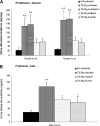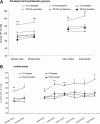Renin-angiotensin system blockade is renoprotective in immune complex-mediated glomerulonephritis
- PMID: 18337487
- PMCID: PMC2396930
- DOI: 10.1681/ASN.2007050607
Renin-angiotensin system blockade is renoprotective in immune complex-mediated glomerulonephritis
Abstract
Blockade of the renin-angiotensin system is renoprotective in a variety of chronic nephropathies, but the direct effect of such treatment in active, immune complex-mediated glomerulonephritis is unknown. This study investigated the short- and long-term effects of an angiotensin-converting enzyme inhibitor (enalapril) and an angiotensin II type 1 receptor blocker (losartan) in thymic stromal lymphopoietin transgenic (TSLPtg) mice, which develop mixed cryoglobulinemia and severe cryoglobulinemia-associated membranoproliferative glomerulonephritis. Enalapril and losartan each reduced hypertension, proteinuria, glomerular extracellular matrix deposition, and mesangial cell activation in TSLPtg mice. These renoprotective effects were not observed with hydralazine treatment, despite a similar antihypertensive effect. Treatment with enalapril or losartan also decreased renal plasminogen activator inhibitor-1 in TSLPtg mice, assessed by immunohistochemistry and quantitative real-time reverse transcriptase-PCR. None of the treatments affected immune complex deposition or macrophage infiltration. Overall, enalapril- and losartan-treated TSLPtg mice survived significantly longer than untreated TSLPtg mice. These studies demonstrate that angiotensin blockade may provide renoprotective benefits, independent of its BP-lowering effect, in the treatment of active immune complex-mediated glomerulonephritis.
Figures










Similar articles
-
Renoprotective effect of small doses of losartan and enalapril in patients with primary glomerulonephritis. Short-term observation.Am J Nephrol. 2002 Jul-Aug;22(4):356-62. doi: 10.1159/000065227. Am J Nephrol. 2002. PMID: 12169868 Clinical Trial.
-
Low-dose angiotensin II receptor antagonists and angiotensin II-converting enzyme inhibitors alone or in combination for treatment of primary glomerulonephritis.Scand J Urol Nephrol. 2004;38(5):427-33. doi: 10.1080/00365590410015687. Scand J Urol Nephrol. 2004. PMID: 15764256 Clinical Trial.
-
Renal and retinal effects of enalapril and losartan in type 1 diabetes.N Engl J Med. 2009 Jul 2;361(1):40-51. doi: 10.1056/NEJMoa0808400. N Engl J Med. 2009. PMID: 19571282 Free PMC article. Clinical Trial.
-
Inhibition of the renin-angiotensin system and cardio-renal protection: focus on losartan and angiotensin receptor blockade.Expert Opin Pharmacother. 2005 Sep;6(11):1931-42. doi: 10.1517/14656566.6.11.1931. Expert Opin Pharmacother. 2005. PMID: 16144512 Review.
-
Does renin-angiotensin system blockade have a role in preventing diabetic retinopathy? A clinical review.Int J Clin Pract. 2011 Feb;65(2):148-53. doi: 10.1111/j.1742-1241.2010.02552.x. Int J Clin Pract. 2011. PMID: 21235695 Review.
Cited by
-
Deletion of activating Fcgamma receptors does not confer protection in murine cryoglobulinemia-associated membranoproliferative glomerulonephritis.Am J Pathol. 2009 Jul;175(1):107-18. doi: 10.2353/ajpath.2009.081159. Epub 2009 Jun 15. Am J Pathol. 2009. PMID: 19528347 Free PMC article.
-
Mice lacking the Cβ subunit of PKA are resistant to angiotensin II-induced cardiac hypertrophy and dysfunction.BMC Res Notes. 2010 Nov 16;3:307. doi: 10.1186/1756-0500-3-307. BMC Res Notes. 2010. PMID: 21080942 Free PMC article.
-
Functional Metabolomics Analysis Elucidating the Metabolic Biomarker and Key Pathway Change Associated With the Chronic Glomerulonephritis and Revealing Action Mechanism of Rhein.Front Pharmacol. 2020 Sep 25;11:554783. doi: 10.3389/fphar.2020.554783. eCollection 2020. Front Pharmacol. 2020. PMID: 33101021 Free PMC article.
-
Podocyte dysfunction in aging--related glomerulosclerosis.Front Biosci (Schol Ed). 2011 Jun 1;3(3):995-1006. doi: 10.2741/204. Front Biosci (Schol Ed). 2011. PMID: 21622249 Free PMC article. Review.
-
ACE-inhibition increases podocyte number in experimental glomerular disease independent of proliferation.J Renin Angiotensin Aldosterone Syst. 2015 Jun;16(2):234-48. doi: 10.1177/1470320314543910. Epub 2014 Aug 20. J Renin Angiotensin Aldosterone Syst. 2015. PMID: 25143333 Free PMC article.
References
-
- Kamar N, Rostaing L, Alric L: Treatment of hepatitis C-virus-related glomerulonephritis. Kidney Int 69: 436–439, 2006 - PubMed
-
- Wolf G, Butzmann U, Wenzel UO: The renin-angiotensin system and progression of renal disease: From hemodynamics to cell biology. Nephron Physiol 93: P3–P13, 2003 - PubMed
-
- Tylicki L, Larczynski W, Rutkowski B: Renal protective effects of the renin-angiotensin-aldosterone system blockade: from evidence-based approach to perspectives. Kidney Blood Press Res 28: 230–242, 2005 - PubMed
-
- Wilkinson-Berka JL, Gibbs NJ, Cooper ME, Skinner SL, Kelly DJ: Renoprotective and anti-hypertensive effects of combined valsartan and perindopril in progressive diabetic nephropathy in the transgenic (mRen-2)27 rat. Nephrol Dial Transplant 16: 1343–1349, 2001 - PubMed
-
- Zheng F, Zeng YJ, Plati AR, Elliot SJ, Berho M, Potier M, Striker LJ, Striker GE: Combined AGE inhibition and ACEi decreases the progression of established diabetic nephropathy in B6 db/db mice. Kidney Int 70: 507–514, 2006 - PubMed
Publication types
MeSH terms
Substances
Grants and funding
LinkOut - more resources
Full Text Sources
Other Literature Sources
Molecular Biology Databases

